Water Footprint and Impact of Water Consumption for Food, Feed, Fuel Crops Production in Thailand
Abstract
:1. Introduction
2. Staple Crops Cultivation in Thailand
| Studied crops | Plantation areas in 2011 (hectare) | ||||
|---|---|---|---|---|---|
| North | Northeast | Central | East | South | |
| Major rice | 2,081,888 | 5,631,790 | 867,531 | 360,430 | 187,646 |
| Second rice | 945,906 | 457,533 | 728,241 | 110,071 | 59,367 |
| Maize | 695,333 | 302,346 | 76,066 | 32,802 | – |
| Soybean | 66,574 | 15,471 | 278 | 373 | – |
| Mungbean | 141,930 | 3,333 | 1,757 | 490 | 234 |
| Peanut | 16,711 | 10,106 | 1,282 | 118 | 634 |
| Cassava | 203,009 | 614,102 | 96,536 | 228,712 | – |
| Sugarcane | 294,267 | 507,617 | 314,411 | 81,226 | – |
| Pineapple | 14,790 | 3,375 | 62,303 | 19,525 | 1,073 |
| Oil palm | 3,185 | 9,109 | 39,559 | 35,698 | 552,072 |
| Coconut | 2,485 | 1,731 | 73,769 | 14,982 | 113,141 |
| Total | 4,466,078 | 7,556,513 | 2,261,733 | 884,427 | 914,167 |
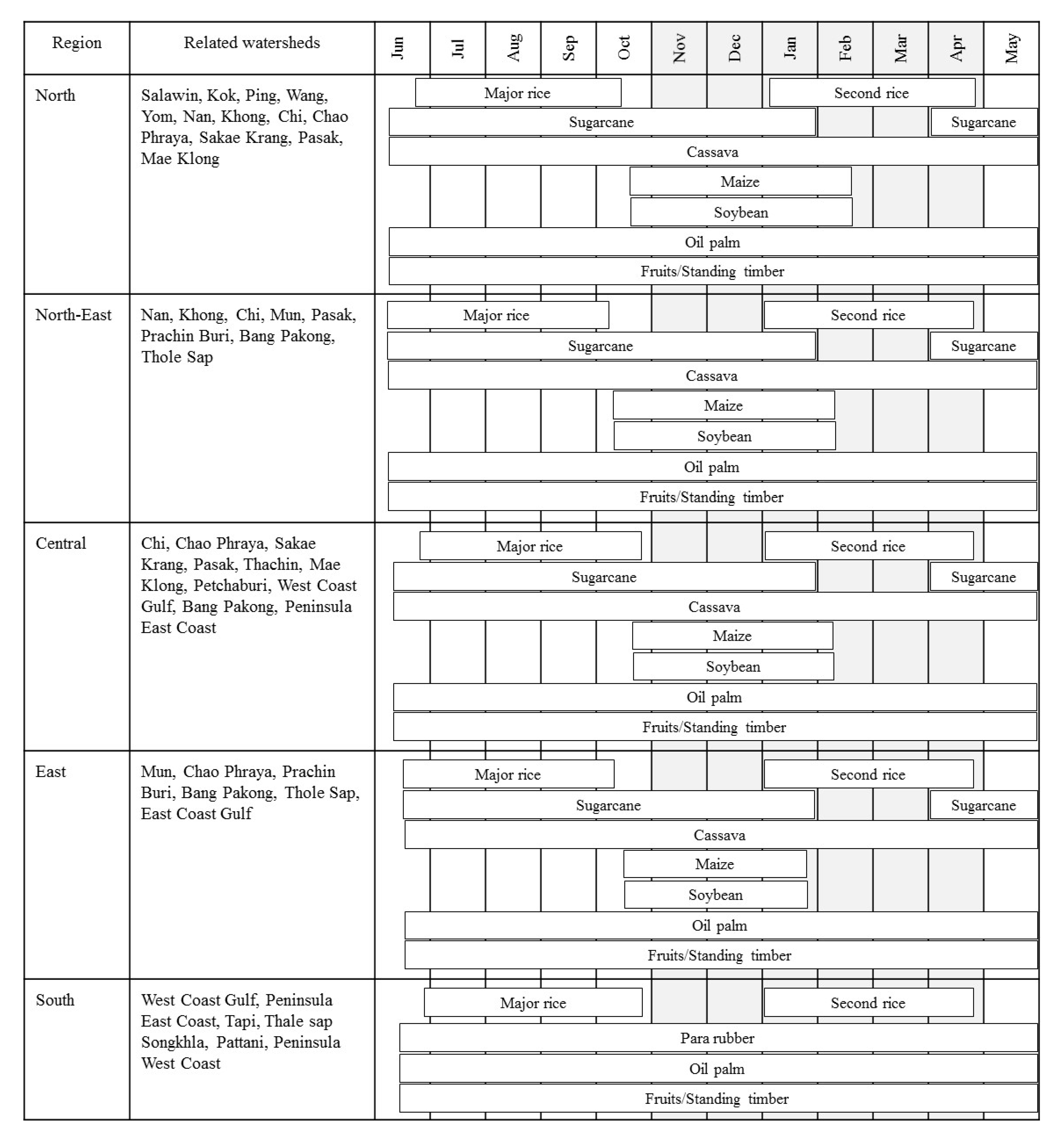
3. Methodology
3.1. Quantification of Crop Water Requirement
 ETcrop (m3/ha)
ETcrop (m3/ha)
- Calculating the evapotranspiration (ETcrop) for each crop grown in each region;
- Calculating the effective rainfall in each region during the crop growing period;
- WFcrop,green is evaluated by comparing the monthly evapotranspiration (ET) of crops during the growing period (in each region) with the effective rainfall during the crop growing period. Then, if ET > effective rainfall, WFcrop,green will be equal to the effective rainfall; however, if ET < effective rainfall, WFcrop,green will be equal to ET;
- WFcrop,blue is evaluated as the “irrigation water” that is required to achieve the crop evapotranspiration if the effective rainfall is not enough, i.e., if ET > effective rainfall, WFcrop,blue = ET—effective rainfall; however, if ET < effective rainfall, WFcrop,blue = 0.
3.2. Water Stress Index (WSI) and Water Use Impact Assessment

 and
and  represent the standard deviations of monthly and annual rainfall over the past ten years of each watershed.
represent the standard deviations of monthly and annual rainfall over the past ten years of each watershed. 

4. Results and Discussion
4.1. Potential Water Requirements of Staple Crops in Thailand
| Staple Crops | Water Footprint (m3/ha) * | Water Footprint (m3/ton **) | ||||
|---|---|---|---|---|---|---|
| Green WF | Blue WF | Total WF | Range (m3/ha) | Average (m3/ton **) | Range (m3/ton **) | |
| Major rice | 4,079 | 1,275 | 5,354 | 4,876–5,570 | 2,005 | 1,224–2,581 |
| Second rice | 1,179 | 3,948 | 5,127 | 3,306–5,823 | 1,487 | 1,147–1,806 |
| Maize | 1,014 | 2,741 | 3,756 | 3,292–4,163 | 982 | 837–1,084 |
| Soybean | 811 | 2,276 | 3,087 | 2,758–3,431 | 1,851 | 1,676–2,344 |
| Mungbean | 565 | 1,488 | 2,053 | 1,428–4,017 | 2,980 | 1,549–6,445 |
| Peanut | 863 | 2,278 | 3,141 | 2,804–3,475 | 2,236 | 1,800–2,580 |
| Cassava | 6,529 | 1,297 | 7,827 | 7,712–7,891 | 399 | 394–413 |
| Sugarcane | 7,920 | 2,442 | 10,362 | 10,037–10,587 | 160 | 150–174 |
| Pineapple | 8,323 | 5,402 | 13,725 | 13,376–13,935 | 611 | 472–747 |
| Oil palm | 8,323 | 5,405 | 13,728 | 13,376–13,935 | 2,941 | 1,072–5,508 |
| Coconut | 8,245 | 5,402 | 13,647 | 13,376–13,921 | 2,474 | 2,028–2,856 |
4.2. Irrigation Water Requirements of Staple Crops Production in Thailand
| Staple Crops | Irrigation Water Requirement (m3/ton) | Range (m3 of Irrigation Water Required/ton) | ||
|---|---|---|---|---|
| Dry season | Wet season | Dry season | Wet season | |
| Major rice | – | 520 | – | 296 (N)–771 (S) |
| Second rice | 1139 | – | 597 (S)–1710 (NE) | – |
| Maize | 850 | – | 680 (N)–953 (NE) | – |
| Soybean | 1628 | – | 1347 (N)–2038 (NE) | – |
| Mungbean | 2998 | – | 1698 (C)–5693 (NE) | – |
| Peanut | 1559 | – | 384 (S)–2158 (E) | – |
| Cassava | 65 | 21 | 52 (N)–80 (NE) | 4 (N)–39 (C) |
| Sugarcane | 28 | 17 | 24 (N)–29 (C) | 5 (N)–34 (C) |
| Pineapple | 226 | 26 | 135 (S)–326 (C) | 6 (N)–67 (C) |
| Oil palm * | 1174 | 90 | 173 (S)–2516 (NE) | 32 (E)–181 (NE) |
| Coconut | 870 | 104 | 450 (S)–1210 (NE) | 32 (N)–179 (C) |
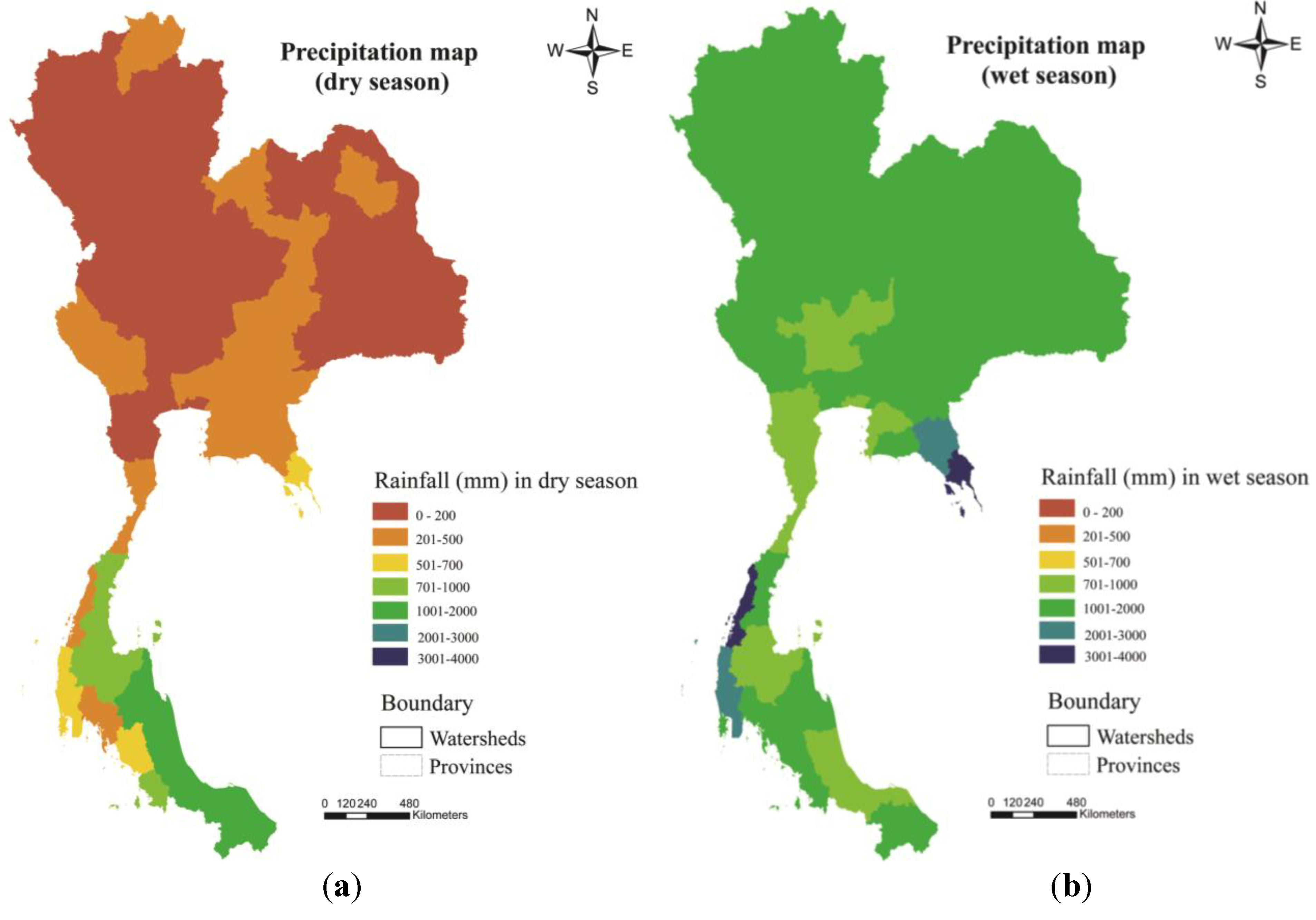
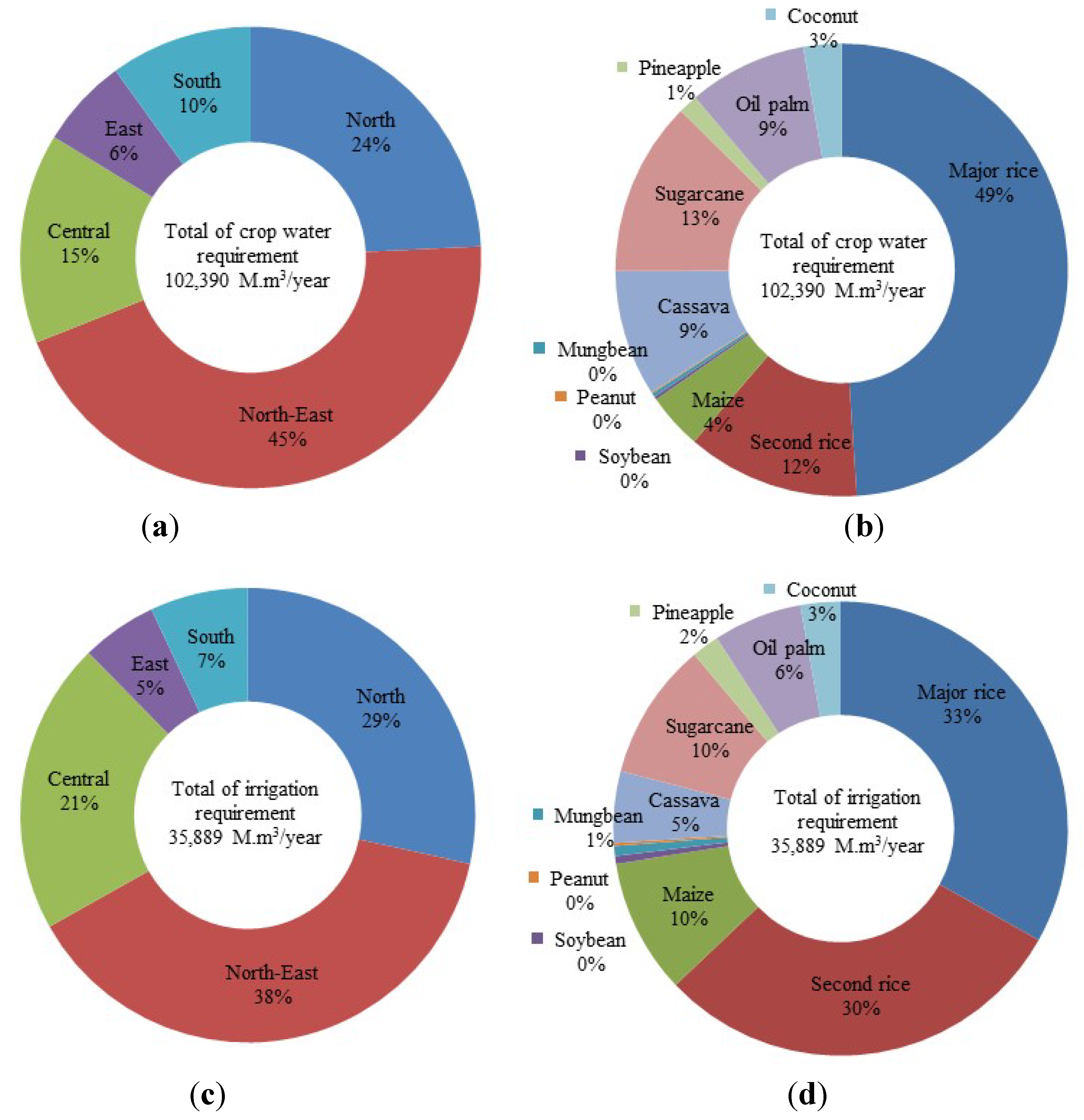
4.3. Impact of Water Use from Agriculture in Thailand
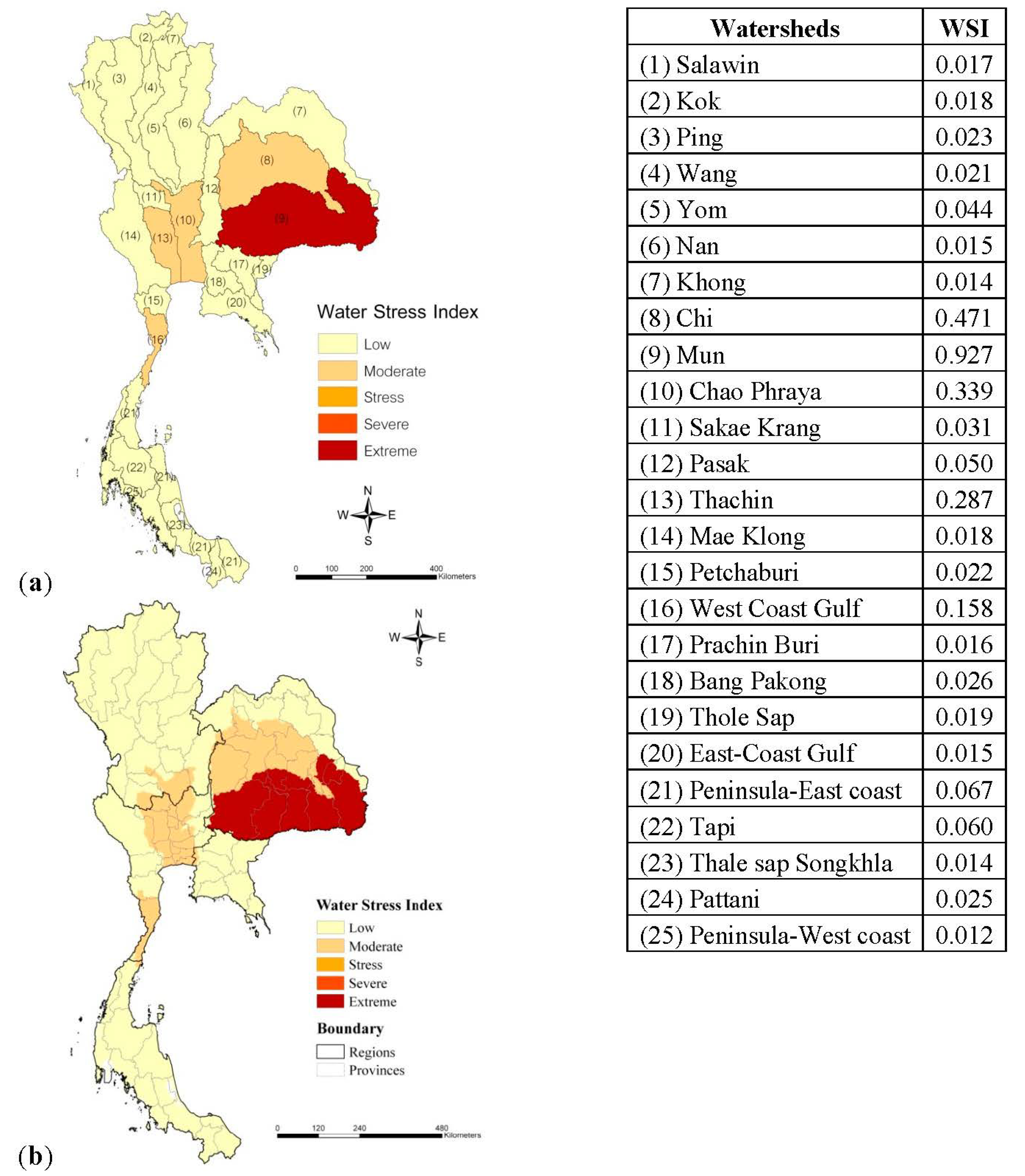
| Region | Related Watershed | Water Deprivation (M·m3H2Oeq) | ||||||||||
|---|---|---|---|---|---|---|---|---|---|---|---|---|
| Major Rice | Second Rice | Maize | Soybean | Mungbean | Peanut | Cassava | Sugarcane | Pineapple | Oil Palm | Coconut | ||
| North | Salawin | 2.02 | 1.75 | 13.14 | 1.01 | 0.67 | 0.23 | 0.26 | 0.11 | – | 0.002 | 0.20 |
| Kok | 12.19 | 20.24 | 11.02 | 1.49 | 0.04 | 0.24 | 0.11 | 0.51 | 0.71 | 0.19 | – | |
| Ping | 21.23 | 52.04 | 16.00 | 2.19 | 1.94 | 0.42 | 7.36 | 9.55 | 1.5 × 10−4 | 0.43 | 0.15 | |
| Wang | 8.58 | 3.29 | 7.74 | 1.26 | 0.18 | 1.17 | 0.12 | 1.14 | 1.79 | 0.01 | 0.05 | |
| Yom | 25.19 | 71.31 | 9.18 | 1.00 | 2.09 | 0.23 | 5.96 | 8.72 | 0.36 | 0.36 | 0.03 | |
| Nan | 29.90 | 55.00 | 36.91 | 0.51 | 7.69 | 0.23 | 2.29 | 10.04 | 0.93 | 0.13 | 0.33 | |
| Khong | 2.51 | 3.27 | 2.92 | 0.08 | 0.25 | 0.03 | 0.05 | 0.24 | 0.12 | 0.03 | 0.01 | |
| Chi | 2.10 | 1.22 | 7.31 | 0.01 | 1.97 | 0.01 | 0.24 | 1.34 | – | – | 0.07 | |
| Chao Phraya | 110.27 | 146.50 | 35.95 | 0.05 | 9.15 | 0.40 | 9.46 | 43.61 | – | 0.14 | 0.66 | |
| Sakae Krang | 178.04 | 250.78 | 36.73 | 0.09 | 9.14 | 0.61 | 17.81 | 70.46 | – | 0.41 | 0.85 | |
| Pasak | 63.35 | 36.99 | 221.04 | 0.38 | 59.57 | 0.42 | 7.19 | 40.39 | – | 1.66 × 10−7 | 2.11 | |
| Mae Klong | 0.77 | 0.67 | 7.27 | 0.19 | 0.38 | 0.09 | 0.15 | 0.06 | – | 1.22 × 10−4 | 0.11 | |
| North-east | Nan | 0.02 | 9.08 × 10−4 | 0.13 | 0.004 | – | 3.59 × 10−5 | 0.01 | 0.01 | 2.6 × 10−4 | 0.002 | 1.40 × 10−4 |
| Khong | 78.20 | 22.17 | 38.49 | 1.26 | 0.01 | 0.73 | 14.51 | 19.79 | 0.10 | 2.39 | 0.12 | |
| Chi | 469.90 | 230.80 | 51.87 | 8.44 | 1.90 | 1.58 | 86.30 | 181.65 | 2.11 | 0.81 | 0.26 | |
| Mun | 1194.18 | 288.65 | 199.41 | 0.24 | 2.77 | 3.62 | 248.47 | 188.83 | 6.5 × 10−4 | 5.30 | 1.21 | |
| Pasak | 120.36 | 36.48 | 44.89 | 0.47 | 0.58 | 0.11 | 41.96 | 33.44 | 0.12 | 0.21 | 0.09 | |
| Prachin Buri | 16.37 | 4.73 | 5.20 | – | 0.07 | 0.01 | 5.69 | 4.21 | – | 0.009 | 0.01 | |
| Bang Pakong | 0.02 | 0.006 | 0.007 | – | 9.71 × 10−5 | 1.97 × 10−5 | 0.008 | 0.006 | – | 1.22 × 10−5 | 1.57 × 10−5 | |
| Thole Sap | 0.17 | 0.02 | 7.79 × 10−5 | – | – | 8.49 × 10−4 | 0.01 | 0.01 | – | 2.25 × 10−4 | 2.62 × 10−5 | |
| Central | Chi | 0.005 | 0.02 | 0.008 | – | 8.20 × 10−5 | 8.19 × 10−5 | 0.003 | 0.01 | – | – | – |
| Chao Phraya | 38.92 | 116.37 | 23.57 | – | 0.26 | 0.25 | 8.40 | 31.03 | 0.02 | 0.40 | 0.17 | |
| Sakae Krang | 1.24 × 10−5 | 2.57 × 10−5 | 1.40 × 10−7 | – | 2.52 × 10−8 | 1.43 × 10−8 | 1.04 × 10−6 | 2.48 × 10−6 | – | – | 5.96 × 10−8 | |
| Pasak | 22.32 | 70.36 | 30.99 | – | 0.33 | 0.33 | 10.47 | 38.16 | – | – | 0.01 | |
| Thachin | 94.88 | 239.79 | 9.29 | 0.04 | 0.03 | 0.04 | 5.62 | 91.60 | 2.92 | 0.56 | 0.54 | |
| Mae Klong | 20.02 | 45.24 | 9.84 | 0.14 | – | 0.11 | 10.22 | 53.68 | 7.76 | 2.34 | 0.87 | |
| Petchaburi | 24.17 | 18.17 | 0.96 | – | – | 0.13 | 1.05 | 10.78 | 10.91 | 2.61 | 4.17 | |
| West Coast Gulf | 7.72 | 2.75 | 0.36 | – | – | 0.03 | 0.01 | 6.84 | 75.78 | 58.68 | 119.22 | |
| Bang Pakong | 0.11 | 0.33 | – | – | – | – | – | – | – | 0.02 | 0.001 | |
| Peninsula-East coast | 0.07 | 0.02 | 0.004 | – | – | 2.21E-4 | – | 0.08 | 0.97 | 0.76 | 1.54 | |
| East | Mun | 0.006 | 0.002 | 0.003 | 1.88 × 10−5 | 3.59 × 10−7 | 7.48 × 10−6 | 0.003 | 0.002 | – | 3.59 × 10−4 | 1.30 × 10−5 |
| Chao Phraya | 2.01 | 3.44 | 0.04 | 0.005 | – | – | 0.57 | 0.22 | 0.07 | 0.14 | 0.10 | |
| Prachin Buri | 104.22 | 59.65 | 39.65 | 0.33 | 0.01 | 0.11 | 48.22 | 35.82 | 0.09 | 5.42 | 0.51 | |
| Bang Pakong | 33.04 | 56.51 | 0.74 | 0.08 | 2.88 × 10−4 | 8.04 × 10−6 | 10.37 | 4.58 | 1.46 | 3.34 | 2.32 | |
| Thole Sap | 136.32 | 17.28 | 63.57 | 0.36 | – | 0.18 | 53.67 | 56.24 | 0.05 | 8.51 | 0.04 | |
| East-Coast Gulf | 0.28 | 0.30 | 0.46 | 6.62 × 10−5 | – | 2.45E-3 | 1.32 | 0.97 | 0.59 | 1.33 | 0.65 | |
| South | West Coast Gulf | 0.03 | 0.01 | – | – | – | 1.39 × 10−4 | – | – | 0.04 | 4.31 | 1.14 |
| Peninsula-East coast | 7.41 | 2.21 | – | – | – | 8.02 × 10−4 | – | – | 0.17 | 32.18 | 8.74 | |
| Tapi | 4.18 | 1.49 | – | – | – | 6.72 × 10−4 | – | – | – | 48.59 | 9.16 | |
| Thale sap Songkhla | 10.36 | 2.12 | – | – | – | – | – | – | – | 1.49 | 0.48 | |
| Pattani | 1.91 | 0.10 | – | – | – | – | – | – | – | 0.42 | 0.57 | |
| Peninsula-West coast | 1.33 | 0.43 | – | – | – | 9.13 × 10−6 | – | – | 0.001 | 9.98 | 0.54 | |
| Total | 2844.7 | 1862.5 | 924.7 | 19.6 | 99.0 | 11.3 | 597.9 | 944.2 | 107.1 | 191.5 | 157.0 | |
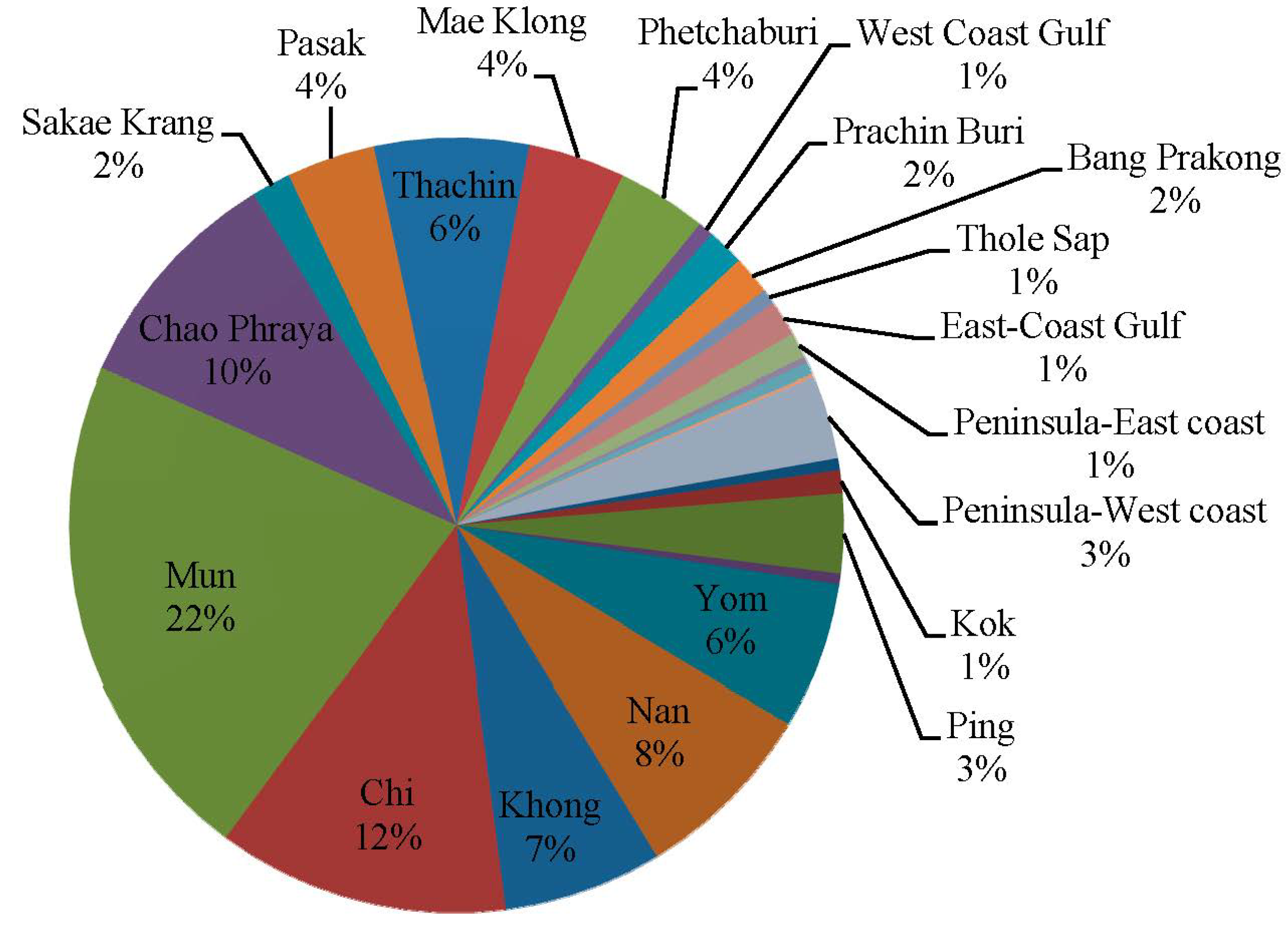
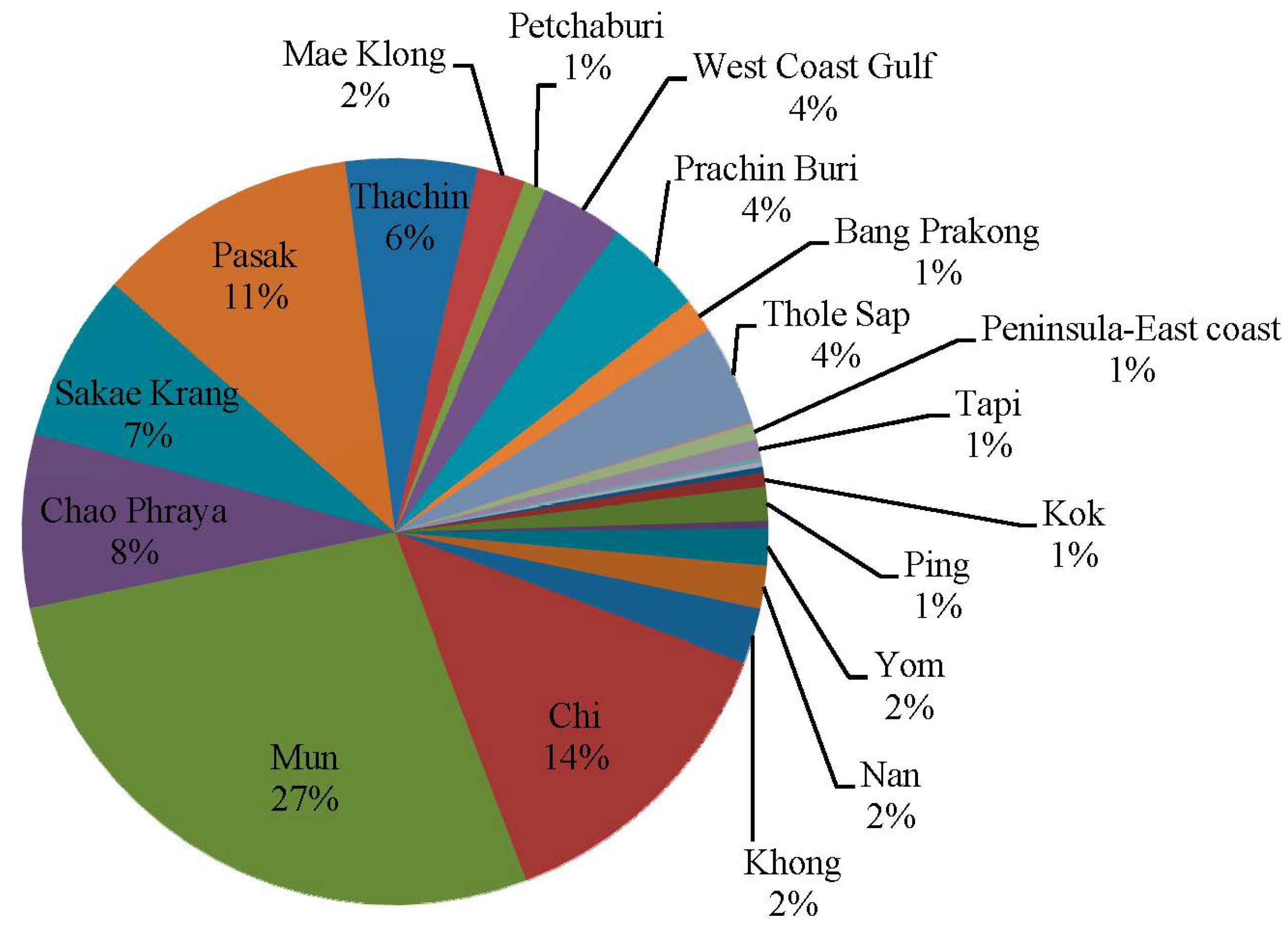
4.4. Recommendations for Further Water Resource Management for Crops Production in Thailand
4.4.1. Crop WF Reduction
4.4.2. Irrigation Development in the High Potential Water Stress Areas
4.4.3. Promoting Expansion of Energy Crop Cultivation in the Suitable Areas
5. Conclusions
Acknowledgments
Author Contribution
Conflicts of Interest
References
- Scanlon, B.R.; Jolly, I.; Sophocleous, M.; Zhang, L. Global impacts of conversions from natural to agricultural ecosystems on water resources: Quantity versus quality. Water Resour. Res. 2007, 43. [Google Scholar] [CrossRef]
- Gordon, L.J.; Max Finlayson, C.; Falkenmark, M. Managing water in agriculture for food production and other ecosystem services. Agr. Water Manag. 2010, 97, 512–519. [Google Scholar] [CrossRef]
- Managing Water under Uncertainty and Risk; The United Nations World Water Development Report 4; Volume 1, World Water Assessment Program (WWAP): Paris, France, 2012.
- Food and Agriculture Organization of the United Nations (FAO). Crop Yield Response to Water; FAO Irrigation and Drainage Paper; Food and Agriculture Organization of the United Nations: Rome, Italy, 2012. [Google Scholar]
- United Nations Environment Programme (UNEP). Global Environment Outlook: Environment for Development (GEO-4); United Nations Environment Programme: Valletta, Malta, 2007. [Google Scholar]
- Bank of Thailand (BOT). Thai Economy: Thailand at a Glance. Available online: http://www.bot.or.th/English/EconomicConditions/Thai/genecon/Pages/Thailand_Glance.aspx (accessed on 22 June 2012).
- Office of Agricultural Economics (OAE). Agricultural Statistics of Thailand 2011; Office of Agricultural Economics: Bangkok, Thailand, 2012. [Google Scholar]
- Hoekstra, A.Y. Virtual Water Trade: Proceedings of the International Expert Meeting on Virtual Water Trade; The United Nations Educational, Scientific and Cultural Organization-International Institute for Hydraulic and Environmental Engineering (UNESCO-IHE): Delft, the Netherlands, 2003.
- Chapagain, A.K.; Hoekstra, A.Y. Water Footprints of Nations; Value of Water Research Report Series No. 16; The United Nations Educational, Scientific and Cultural Organization-International Institute for Hydraulic and Environmental Engineering (UNESCO-IHE): Delft, the Netherlands, 2004. [Google Scholar]
- Hoekstra, A.Y.; Chapagain, A.K.; Aldaya, M.M.; Mekonnen, M.M. The Water Footprint Assessment Manual: Setting the Global Standard; Water Footprint Network: Godalming, UK, 2011. [Google Scholar]
- Chapagain, A.K.; Hoekstra, A.Y.; Savenije, H.H.G.; Gautam, R. The water footprint of cotton consumption: An assessment of the impact of worldwide consumption of cotton products on the water resources in the cotton producing countries. Ecol. Econ. 2006, 60, 186–203. [Google Scholar] [CrossRef]
- Mekonnen, M.M.; Hoekstra, A.Y. The green, blue and grey water footprint of crops and derived crop products. Hydrol. Earth Syst. Sci. 2011, 15, 1577–1600. [Google Scholar] [CrossRef]
- Gerbens-Leenes, W.; Hoekstra, A.Y. The water footprint of sweeteners and bio-ethanol. Environ. Int. 2012, 40, 202–211. [Google Scholar] [CrossRef]
- Jefferies, D.; Muñoz, I.; Hodges, J.; King, V.J.; Aldaya, M.; Ercin, A.E.; Milà I Canals, L.; Hoekstra, A.Y. Water footprint and life cycle assessment as approaches to assess potential impacts of products on water consumption. Key learning points from pilot studies on tea and margarine. J. Clean. Prod. 2012, 33, 155–166. [Google Scholar]
- Bocchiola, D.; Nana, E.; Soncini, A. Impact of climate change scenarios on crop yield and water footprint of maize in the Po valley of Italy. Agric. Water Manag. 2013, 116, 50–61. [Google Scholar] [CrossRef]
- Wichelns, D. Virtual water and water footprints offer limited insight regarding important policy questions. Int. J. Water Resour. Dev. 2010, 26, 639–651. [Google Scholar] [CrossRef]
- Chapagain, A.K.; Tickner, D. Water Footprint: Help or Hindrance? Water Alternatives. 2012, 5, 563–581. [Google Scholar]
- Brown, A.; Matlock, M.D. A Review of Water Scarcity Indices and Methodologies; White Paper #106; The Sustainability Consortium: Fayetteville, AR, USA, 2011. [Google Scholar]
- Hoekstra, A.Y.; Mekonnen, M.M.; Chapagain, A.K.; Mathews, R.E.; Richter, B.D. Globa Monthly Water Scarcity: Blue Water Footprints versus Blue Water Availability. PLoS ONE. 2012, 7. [Google Scholar] [CrossRef]
- Pfister, S.; Koehler, A.; Hellweg, S. Assessing the Environmental Impacts of Freshwater Consumption in LCA. Environ. Sci. Technol. 2009, 43, 4098–4104. [Google Scholar] [CrossRef]
- Bayart, J.B.; Bulle, C.; Deschênes, L.; Margni, M.; Pfister, S.; Vince, F.; Koehler, A. A framework for assessing off-stream freshwater use in LCA. Int. J. Life Cycle Assess. 2010, 15, 429–453. [Google Scholar]
- Berger, M.; Finkbeiner, M. Water footprinting: How to address water use in life cycle assessment? Sustainability 2010, 2, 919–944. [Google Scholar] [CrossRef]
- Milà i Canals, L.; Chenoweth, J.; Chapagain, A.; Orr, S.; Antón, A.; Clift, R. Assessing freshwater use impacts in LCA: Part I—Inventory modeling and characterization factors for the main impact pathways. Int. J. Life Cycle Assess. 2009, 14, 28–42. [Google Scholar] [CrossRef]
- Fingerman, K.R.; Berndes, G.; Orr, S.; Richter, B.; Vugteveen, P. Impact assessment at the bioenergy-water nexus. Biofuels Bioprod. Biorefin. 2011, 5, 375–386. [Google Scholar] [CrossRef]
- Nilsalab, P.; Gheewala, S.H.; Mungkung, R. Water Assessment of agrofuels feedstock cultivation: Methodology approaches. Environ. Nat. Resour. J. 2012, 10, 11–20. [Google Scholar]
- Kaenchan, P.; Gheewala, S.H. A review of the water footprint of biofuel crop production in Thailand. J. Sustain. Energy Environ. 2012, 4, 45–52. [Google Scholar]
- Kongboon, R.; Sampattagul, S. Investigating the Water Footprint in Bio-ethanol Crops Production in the Northern of Thailand. In Proceedings of the 3rd International Conference on Green and Sustainable Innovation, Chiang Mai, Thailand, 24–26 May 2012.
- Sukumalchart, T.; Pornprommin, A.; Lipiwattanakarn, S. Monthly Water Footprint of Maize in Major Cultivated Areas of Thailand. In Proceeding of the 1st EIT International Conference on Water Resources Engineering Title “Water Resources Management under Risk of Natural Hazard and Data Uncertainty”, Phetchaburi, Thailand, 18–19 August 2011.
- Allen, R.G.; Pereira, L.S.; Raes, D.; Smith, M. Crop Evapotranspiration: Guidelines for Computing Crop Water Requirements; FAO Drainage and Irrigation Paper 56; Food and Agriculture Organization: Rome, Italy, 1988. [Google Scholar]
- Irrigation Water Management (IWM). The Study on Reference Crop Evapotanspiration by Penman-Montheith Method of the Irrigation Water Management Division; Royal Irrigation Department: Bangkok, Thailand, 2011.
- Irrigation Water Management (IWM). Crop coefficient (Kc) of Penman-Monteith Irrigation Water Management Division; Royal Irrigation Department: Bangkok, Thailand, 2008.
- Kwanyuen, B.; Numkhang, P.; Phuthongsook, W.; Tonwiboonsak, S. The study of cassava’s crop coefficient (Kc). In The 11st TSAE Conference: Innovation in Agricultural Engineering for Sufficiency Economy and Empowered Communities; Nakhon Pathom, Thailand: 6–7 May 2010.
- Hydro and Agro Informatics Institute (HAII). Concepts of the study and assessment on water requirement. Available online: http://www.haii.or.th/wiki/index.php (accessed on 17 October 2012).
- Royal Irrigation Department (RID). Crop Water Requirement for Pre-Feasibility Study; Project Planning Standard Group, Office of Project Management, Royal Irrigation Department: Bangkok, Thailand, 2011. [Google Scholar]
- Ridoutt, B.G.; Pfister, S. A revised approach to water footprinting to make transparent the impacts of consumption and production on global freshwater scarcity. Glob. Environ. Change 2010, 20, 113–120. [Google Scholar] [CrossRef]
- Royal Irrigation Department (RID). Planning on irrigation development for 25 watersheds. Office of Water Management and Hydrology, Royal Irrigation Department: Bangkok, Thailand, 2011. [Google Scholar]
- Royal Irrigation Department (RID). Work Manual No.8/16: Assessing water consumption by sectors. Available online: http://irrigation.rid.go.th/rid10/om/Work%20Manual/manual-08.pdf (accessed on 17 October 2012).
- Pfister, S.; Bayer, P.; Koehler, A.; Hellweg, S. Projected water consumption in future global agriculture: Scenarios and related impacts. Sci. Total Environ. 2011, 409, 4206–4216. [Google Scholar] [CrossRef]
- Gheewala, S.H.; Silalertruksa, T.; Nilsalab, P.; Mungkung, R.; Perret, S.R.; Chaiyawannakarn, N. Implications of the biofuels policy mandate in Thailand on water: The case of bioethanol. Bioresour. Technol. 2013, 150, 457–465. [Google Scholar] [CrossRef]
- Bouman, B.A.M.; Peng, S.; Castaneda, A.R.; Visperas, R.M. Yield and water use of irrigated tropical aerobic rice systems. Agric. Water Mange. 2005, 74, 87–105. [Google Scholar] [CrossRef]
- Food and Agriculture Organization of the United Nations (FAO). Water Management in Rice in Asia: Some Issues for the Future; Regional Office for Asia and the Pacific: Bangkok, Thailand, 2000. [Google Scholar]
- Kredsook, N.; Boontham, A. Standard Yield Trial for Sugarcane Yield and Quality: Plant Cane. In The 49th Annual Conference, Kasetsart University, Bangkok, Thailand, 1–4 February 2011.
© 2014 by the authors; licensee MDPI, Basel, Switzerland. This article is an open access article distributed under the terms and conditions of the Creative Commons Attribution license (http://creativecommons.org/licenses/by/3.0/).
Share and Cite
Gheewala, S.H.; Silalertruksa, T.; Nilsalab, P.; Mungkung, R.; Perret, S.R.; Chaiyawannakarn, N. Water Footprint and Impact of Water Consumption for Food, Feed, Fuel Crops Production in Thailand. Water 2014, 6, 1698-1718. https://doi.org/10.3390/w6061698
Gheewala SH, Silalertruksa T, Nilsalab P, Mungkung R, Perret SR, Chaiyawannakarn N. Water Footprint and Impact of Water Consumption for Food, Feed, Fuel Crops Production in Thailand. Water. 2014; 6(6):1698-1718. https://doi.org/10.3390/w6061698
Chicago/Turabian StyleGheewala, Shabbir H., Thapat Silalertruksa, Pariyapat Nilsalab, Rattanawan Mungkung, Sylvain R. Perret, and Nuttapon Chaiyawannakarn. 2014. "Water Footprint and Impact of Water Consumption for Food, Feed, Fuel Crops Production in Thailand" Water 6, no. 6: 1698-1718. https://doi.org/10.3390/w6061698
APA StyleGheewala, S. H., Silalertruksa, T., Nilsalab, P., Mungkung, R., Perret, S. R., & Chaiyawannakarn, N. (2014). Water Footprint and Impact of Water Consumption for Food, Feed, Fuel Crops Production in Thailand. Water, 6(6), 1698-1718. https://doi.org/10.3390/w6061698





